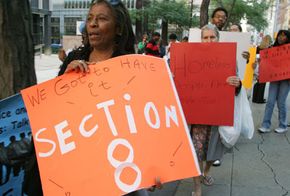Because Section 8 is not considered an entitlement benefit, everyone who qualifies for a housing voucher doesn't necessarily receive one. According to recent estimates, only about 25 percent of the families qualifying for aid receive it. In many areas, qualified families face fierce competition for vouchers. Waiting lists are often long. Because of huge demand, some local housing authorities have even stopped accepting applications entirely. For example, over 2,300 families are on Chicago's waiting list. Recipients are chosen from the waiting list by a monthly lottery; until the list is exhausted, the application process is closed [source: Chicago Housing Choice Voucher Program].
These realities aside, if you are in a low-income group and you need rent assistance or other aid under the voucher program, you should first determine if you meet some basic income requirements. Income requirements vary from one area to the next, but in general your family will need to earn no more than 50 percent of the median income in your area. HUD estimates different areas' median incomes every year.
In 2007, the national median income for a family of three was about $52,000. So, to qualify, your family of three would have to earn less than $26,000 a year. Remember, this limit applies to total household income -- all the income earned by everyone in the household combined.
Another consideration is the number of people in your family. The fewer people in your household, the lower your Section 8 income limit.
HUD and its local agencies also consider other factors when determining applicants' eligibility. Homelessness and factors unique to certain locations (such as participation in a local welfare-to-work program) are often taken into consideration. Other criteria that may help you qualify include:
- being age 62 or older
- being a U.S. Armed Services veteran, widow or widower
- working more than 42 hours per week
- being disabled
- having U.S. citizenship or legal immigrant status
- currently residing in a shelter
- having children
Local housing agencies must also give preference to extremely low-income families, those with household earnings less than 30 percent of an area's median income. Of the new applicants admitted to the program each year, 75 percent must be extremely low-income.
If you think you qualify for a Section 8 housing voucher, you should contact the public housing agency in your area. Contact information, including toll-free phone numbers, addresses and e-mail addresses, can be found on the HUD Web site. Remember, no one should ever charge you for a Section 8 application. Anyone who sells an application or a voucher is committing fraud.
If you'd like to learn more about Section 8, you can follow the links on the next page.


